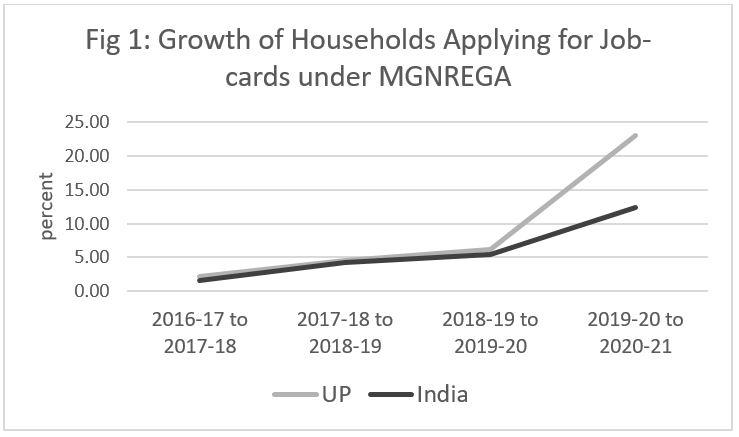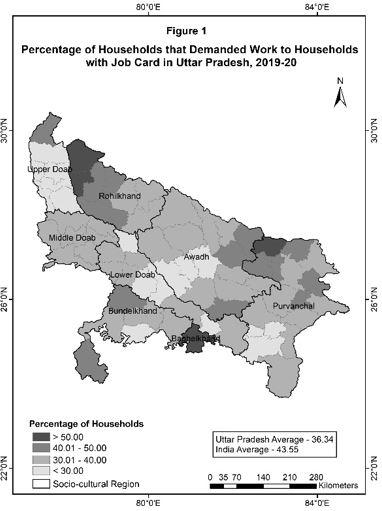Woes And Lows in Uttar Pradesh: Rural Distress And Government’s Response Through MGNREGA During Covid
There are adequate indications from large-scale government surveys on employment and unemployment to show that in the past decade, massive in-situ job losses were witnessed in rural Uttar Pradesh. The outmigration and the anguished return of migrants took place in the midst of a rural labour market crisis.
RURAL CRISIS AMONG WORKERS IN UTTAR PRADESH
Between 2011-12 (NSSO Employment-Unemployment Survey) and 2018-19 (Periodic Labour Force Survey), the male rural workforce above 15 years of age reduced by 3.9 million, whereas the number of rural women workers of the same age group fell by 5.68 million in Uttar Pradesh. Given that a far lower proportion among women are workers, (27.3% compared to 80.7% among men in 2011-12), the magnitude of decline among women is hard to confront. Correspondingly, all categories of workers in agriculture, i.e., cultivators and agricultural labourers, particularly the latter, fell by significant numbers.
In the quarter following the nationwide lockdown in March 2020, the unemployment rates were at 8% and 25.6% for men and women respectively (the Centre for Monitoring Indian Economy (CMIE) May-August 2020); a year later, corresponding rates stood at 4.8% and 24% in the state. Nearly an equivalent percentage of women wanted or needed to work but did not look for work (arguably because they did not expect to find the kind of jobs that they could participate in); this took the greater unemployment rate to an astounding 48.2% for women in May-August 2021 (Unemployment in India: A statistical profile, CMIE May-August 2021).
SHARP INCREASES IN MGNREGA JOB DEMAND
There has been an unprecedented growth in enrolment for job cards by rural households under the programme in Uttar Pradesh indicative of increased job demand in the last few years. Between 2016 and 2021, the rate at which applications for job cards grew in the state annually has been consistently higher than the country average (Figure 1). This gap widened sharply between 2019-20 and 2020-21, as the post-COVID-19 job losses hit the state more sharply due to the return of migrants to the villages, arguably to the districts that already had a shortage of employment.

The increase of the share of households that demanded work out of those that held a job card increased across the state due to the lockdown related job losses (Figures 1 and 2). The only region that had a low demand were households in and around the NCR region.

HALF-HEARTED RESPONSE TO MEET DEMAND FOR WORK
The coverage of MGNREGA in Uttar Pradesh was below the required level, given its share of rural poverty and rural population in the country. As per a report in June 2020, the additional chief secretary (home) of Uttar Pradesh claimed that the state during the post-pandemic crisis accounted for 18% of the total workers employed under the Mahatma Gandhi National Rural Employment Guarantee Act (MGNREGA) in the country. Given that Uttar Pradesh accounts for a slightly higher rural population share of the country and more importantly, has a far higher share of rural households under the poverty line (39.4% compared to the Indian average of 33.8%), this coverage seems inadequate.
To make matters worse, not only the quantum of work through MGNREGA but the payment of wages was below par in Uttar Pradesh. Non-payment or delayed payment of wages on time have been reported extensively from Uttar Pradesh (Jafri 2021, Devi 2021, Nandy 2020). This has been particularly problematic during the COVID-19 crisis as workers in their intense distress wanted ready money at hand soon after they worked. This lack of faith in the state government in making payments when most needed was manifested in the fact that only 20% of the workers seeking work wanted to work in the scheme during the recent crisis.
The ‘surplus and unemployed’ rural labour force reached an all-time high during the Covid crisis in 2020-21, precisely the group MGNREGA aims to provide relief to. The share of households that worked to households that had job cards stood at 44% and 49% for Uttar Pradesh and India respectively for the crisis year, i.e., 2020-21 (Table 1). The 100-day threshold, mandated by the scheme, has been crossed by a minuscule of the households among those that worked (Table 1). Even in 2020-21, where the demand had shot up, this share reached a poor 8.3% and 9.5% coverage for the state and the country respectively. The overall status can be even better assessed by looking at the average person-days of work received per household. In 2020-21, the state figure is lower by a massive 10% point compared to the country average (Table 1).

POOR TARGETING OF MGNREGA IN UTTAR PRADESH
A comparison of Figures 2 and 3 shows that the average person-days of work under the scheme has not responded to the spatiality of demand. For example, parts of Rohilkhand and Northern Purvanchal that had high demand under the scheme is shown to have received low average person-days of work under the programme in 2020-21. On the other hand, the region adjacent to Delhi characterised by relatively low demand received relatively higher person-days of work during the same year.

The rural livelihood distress in the past decade was felt much more sharply by the women compared to the men in Uttar Pradesh, as said earlier. Given this backdrop, and the fact that the scheme holds special provisions to facilitate the participation of women, the MGNREGS implementation in Uttar Pradesh represented an opportunity to cushion the loss of jobs among women in the state. However, on this account, the performance in the state is far worse than the country average, as the share of women person-days barely crosses the mandated one-third mark in the state between 2016-17 and 2020-21 (Figure 4). The principle of social inclusion embedded in the spirit of the scheme was seen wanting in the implementation of the scheme in the state, where the SC households fared much worse than those in the country (Figure 5).


MGNREGA IN UTTAR PRADESH: A MISSED OPPORTUNITY
Uttar Pradesh was hit by the Covid-related livelihood crisis when it was already reeling under a grave rural employment distress, in particular with respect to women workers. An aggressive and sensitive implementation of the MGNREGS scheme could have somewhat muted the blow of the shock of the job losses post-lockdown (Afridi et al 2021). Given the higher-than-average rural poverty rates and the phenomenon of return migration to the state, the relative performance of the state with respect to the country needed to have a greater extent and depth, at the same time reaching out particularly to the vulnerable households and women. Spatially, it needed to focus on the regions with higher demand. However, on almost all counts the state’s performance marks a lost opportunity.
Sucharita Sen is a professor at the Centre for the Study of Regional Development, Jawaharlal Nehru University.
Get the latest reports & analysis with people's perspective on Protests, movements & deep analytical videos, discussions of the current affairs in your Telegram app. Subscribe to NewsClick's Telegram channel & get Real-Time updates on stories, as they get published on our website.
























